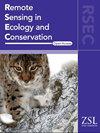Early spectral dynamics are indicative of distinct growth patterns in post‐wildfire forests
IF 4.3
2区 环境科学与生态学
Q1 ECOLOGY
引用次数: 0
Abstract
Western North America has seen a recent dramatic increase in large and often high‐severity wildfires. After forest fire, understanding patterns of structural recovery is important, as recovery patterns impact critical ecosystem services. Continuous forest monitoring provided by satellite observations is particularly beneficial to capture the pivotal post‐fire period when forest recovery begins. However, it is challenging to optimize optical satellite imagery to both interpolate current and extrapolate future forest structure and composition. We identified a need to understand how early spectral dynamics (5 years post‐fire) inform patterns of structural recovery after fire disturbance. To create these structural patterns, we collected metrics of forest structure using high‐density Remotely Piloted Aircraft (RPAS) lidar (light detection and ranging). We employed a space‐for‐time substitution in the highly fire‐disturbed forests of interior British Columbia. In this region, we collected RPAS lidar and corresponding field plot data 5‐, 8‐, 11‐,12‐, and 16‐years postfire to predict structural attributes relevant to management, including the percent bare ground, the proportion of coniferous trees, stem density, and basal area. We compared forest structural attributes with unique early spectral responses, or trajectories, derived from Landsat time series data 5 years after fire. A total of eight unique spectral recovery trajectories were identified from spectral responses of seven vegetation indices (NBR, NDMI, NDVI, TCA, TCB, TCG, and TCW) that described five distinct patterns of structural recovery captured with RPAS lidar. Two structural patterns covered more than 80% of the study area. Both patterns had strong coniferous regrowth, but one had a higher basal area with more bare ground and the other pattern had a high stem density, but a low basal area and a higher deciduous proportion. Our approach highlights the ability to use early spectral responses to capture unique spectral trajectories and their associated distinct structural recovery patterns.早期光谱动态显示了野火后森林的独特生长模式
北美西部最近发生的大规模野火急剧增加,而且往往非常严重。森林火灾后,了解结构恢复的模式非常重要,因为恢复模式会影响关键的生态系统服务。卫星观测提供的连续森林监测特别有利于捕捉火灾后森林开始恢复的关键时期。然而,优化光学卫星图像以推断当前和未来的森林结构和组成是一项挑战。我们发现有必要了解早期光谱动态(火灾后 5 年)如何为火灾干扰后的结构恢复模式提供信息。为了创建这些结构模式,我们使用高密度遥控飞机(RPAS)激光雷达(光探测和测距)收集了森林结构指标。我们在不列颠哥伦比亚省内陆受火灾严重干扰的森林中采用了空间换时间的方法。在该地区,我们收集了 RPAS 激光雷达和相应的野外地块数据,用于预测火灾后 5、8、11、12 和 16 年与管理相关的结构属性,包括裸地百分比、针叶树比例、茎干密度和基部面积。我们将森林结构属性与火灾发生 5 年后从 Landsat 时间序列数据中得出的独特早期光谱响应或轨迹进行了比较。从七种植被指数(NBR、NDMI、NDVI、TCA、TCB、TCG 和 TCW)的光谱响应中,共识别出八种独特的光谱恢复轨迹,它们描述了用 RPAS 激光雷达捕捉到的五种不同的结构恢复模式。两种结构模式覆盖了 80% 以上的研究区域。这两种模式都有较强的针叶树再生,但其中一种模式的基部面积较大,裸地较多;另一种模式的茎干密度较高,但基部面积较小,落叶比例较高。我们的方法强调了利用早期光谱响应捕捉独特光谱轨迹及其相关的独特结构恢复模式的能力。
本文章由计算机程序翻译,如有差异,请以英文原文为准。
求助全文
约1分钟内获得全文
求助全文
来源期刊

Remote Sensing in Ecology and Conservation
Earth and Planetary Sciences-Computers in Earth Sciences
CiteScore
9.80
自引率
5.50%
发文量
69
审稿时长
18 weeks
期刊介绍:
emote Sensing in Ecology and Conservation provides a forum for rapid, peer-reviewed publication of novel, multidisciplinary research at the interface between remote sensing science and ecology and conservation. The journal prioritizes findings that advance the scientific basis of ecology and conservation, promoting the development of remote-sensing based methods relevant to the management of land use and biological systems at all levels, from populations and species to ecosystems and biomes. The journal defines remote sensing in its broadest sense, including data acquisition by hand-held and fixed ground-based sensors, such as camera traps and acoustic recorders, and sensors on airplanes and satellites. The intended journal’s audience includes ecologists, conservation scientists, policy makers, managers of terrestrial and aquatic systems, remote sensing scientists, and students.
Remote Sensing in Ecology and Conservation is a fully open access journal from Wiley and the Zoological Society of London. Remote sensing has enormous potential as to provide information on the state of, and pressures on, biological diversity and ecosystem services, at multiple spatial and temporal scales. This new publication provides a forum for multidisciplinary research in remote sensing science, ecological research and conservation science.
 求助内容:
求助内容: 应助结果提醒方式:
应助结果提醒方式:


